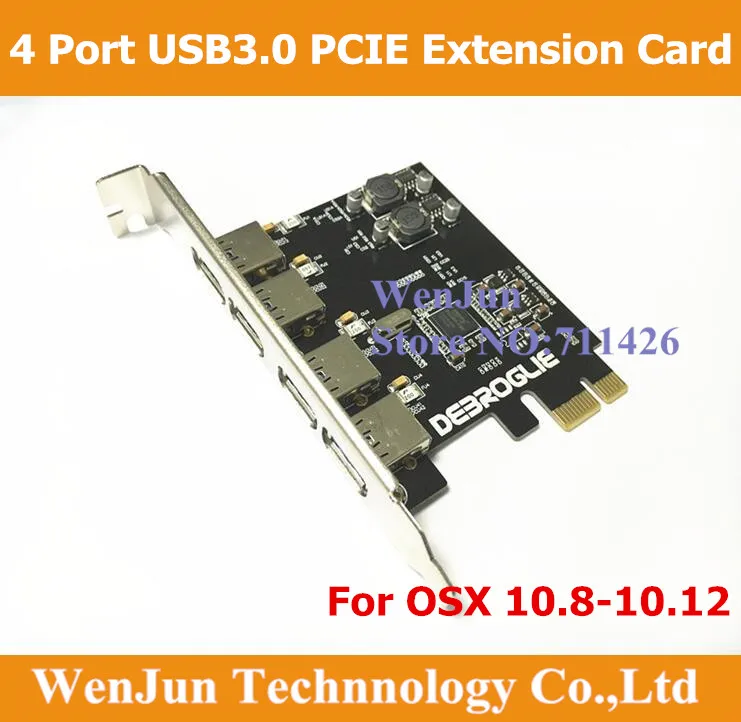
- 4 PORT SUPERSPEED USB 3.0 PCIE CARD UPGRADE FOR MAC PRO 2006 2012 *HSIERRA 10.13 UPDATE
- 4 PORT SUPERSPEED USB 3.0 PCIE CARD UPGRADE FOR MAC PRO 2006 2012 *HSIERRA 10.13 FULL
- 4 PORT SUPERSPEED USB 3.0 PCIE CARD UPGRADE FOR MAC PRO 2006 2012 *HSIERRA 10.13 PRO
- 4 PORT SUPERSPEED USB 3.0 PCIE CARD UPGRADE FOR MAC PRO 2006 2012 *HSIERRA 10.13 PC
Most of the efforts recently have gone into building cheap DRAMless SATA drives based on ever more cost-effective types of NAND. New releases in the high-end SATA SSD market are rare events these days. Endurance should not be an issue either, with the 4TB model offering an endurance rating of no less than 5,600 TBW (terabytes written). Sequential performance is at the top of the charts, as are its 100K read and 90K random write IOPS.
4 PORT SUPERSPEED USB 3.0 PCIE CARD UPGRADE FOR MAC PRO 2006 2012 *HSIERRA 10.13 PRO
This drive outperforms the old performance leader Samsung 860 PRO in several areas while being considerably less expensive since it uses TLC instead of MLC NAND.

Seagate was quick to take advantage of the Phison S12 controller that was released in the middle of 2020, and the result was the impressive FireCuda 120. Seagate FireCuda 120īesides Samsung, Seagate is one of the very few manufacturers that are still actively developing new products in the high-end SATA space. If your computer has an available NVMe-capable PCIe M.2 slot, this is the form factor you should be looking at first.īest M.2 PCIe/NVMe SSDs Best 2.5-inch SATA SSDs 1. If you use a Gen3 system, the Samsung 970 EVO Plus is still a class leader.įor our more complete list of SSDs, we’ll start with 2.5″ SATA drives, which are all bandwidth-limited compared to more modern interfaces/protocols such as PCI-express/NVMe (normally in the M.2 form factor). This includes a combination of AMD’s X570, B550, or TRX40 chipsets and 3rd- or 5th-gen Ryzen/Threadripper CPUs, or Intel’s 11th-gen Rocket Lake CPUs or later.
4 PORT SUPERSPEED USB 3.0 PCIE CARD UPGRADE FOR MAC PRO 2006 2012 *HSIERRA 10.13 FULL
Note that the M.2/PCIe FireCuda 530, like its close competitors the Samsung 980 PRO and WD Black SN850, requires a Gen4-capable platform to run at full speed over the PCI Express 4.0 interface. As of October 2021, Seagate offers some of the best SSDs in both the SATA and PCIe categories in the form of the FireCuda 120 and 530, respectively. Samsung was a market leader in the SSD space for many years, but since quite recently, the other storage giants Western Digital and Seagate are also vying for top positions.
4 PORT SUPERSPEED USB 3.0 PCIE CARD UPGRADE FOR MAC PRO 2006 2012 *HSIERRA 10.13 UPDATE
Last update on / Affiliate links / Images from Amazon Product Advertising API
4 PORT SUPERSPEED USB 3.0 PCIE CARD UPGRADE FOR MAC PRO 2006 2012 *HSIERRA 10.13 PC
They don’t necessarily represent the best value but are definitely some of the speediest storage devices that you can use in your PC build today.

For a more complete story, don’t hesitate to read the reviews linked to in the descriptions.įirst, a quick look at the drives that we consider leaders in their respective form factors. To keep it simple, rankings are based on an average of read/write transfer rates, with additional weight given to drives with high random performance, as this is typically associated with the best real-world performance. As always, what is “best” in your case is will depend on your individual use case, at least to an extent. This page is intended as a rough guide to the best SSDs on the market in the common form factors supported by consumer motherboards. As of 2021, the fastest SSDs in the consumer market use the PCI Express (PCIe) Gen4 interface, which offers twice the bandwidth of Gen3 – and the best Gen4 drives are already using most (if not all) of this bandwidth. Today, the SATA interface used by the first SSD generations has been fully saturated for years, and the same thing has happened to their much faster PCIe Gen3 successors. In the past decade, no other hardware upgrade has delivered such a dramatic improvement to the overall user experience as the shift from slow hard drives to fast solid state drives. When using links on our site to make a purchase, we may earn an affiliate commission.


 0 kommentar(er)
0 kommentar(er)
